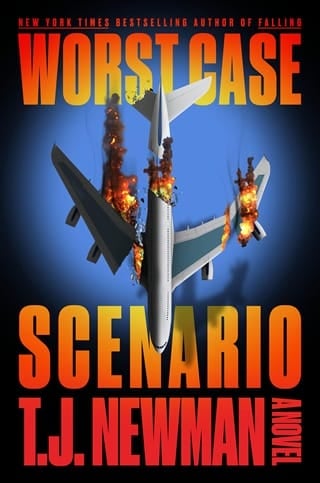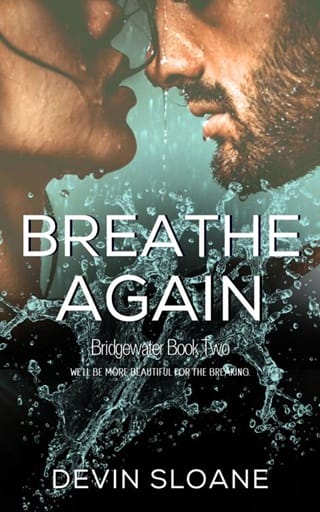Chapter Twenty-One
CHAPTER TWENTY-ONE
COUNTDOWN TO ZERO HOUR 12 HOURS AND 43 MINUTES
STEVE STARED DOWN into the pool at the spent fuel rods.
What happens if he touches the rods?
He dies.
George had asked the question. He’d thought Joss was joking. Steve knew she was not.
The fuel rods were highly radioactive, she’d explained, but the four hundred thousand gallons of water in the forty-foot-deep pool made being near them safe. The water worked in two ways: One, it kept the rods cool, and two, it acted as a radiation shield. The farther you were from the rods, the safer it was. The closer you went, the more dangerous it got. When she said that, that was when George had asked his question.
Get in, get out, Steve thought. Just like he’d told his crew earlier in the day. Work fast, and it’d be fine.
Steve sat on the edge of the pool in full scuba gear, the condition of which had been a little concerning when he’d suited up. Brittle rubber, rusted metal, warped plastic; no one had commented on any of it, even though they’d all noticed. What else were they going to use? He adjusted R.J.’s tight wetsuit and watched through the bean-shaped glass of the industrial dive helmet as tiny flecks of black neoprene rubber shed from the second skin.
“Can you check the connection for my air?” Steve asked, hearing his own tinny voice echo through the heavy, hot, carbon-fiber-reinforced fiberglass helmet. George, beside him in full hazmat gear, looked up from checking his own equipment.
“Can you breathe okay?” George asked.
“Yeah. But just—just check it for me, will you?”
It was the piece of equipment Steve was most worried about.
Because industrial divers needed to stay underwater for long periods, they used SSA—surface-supplied air—as opposed to a traditional scuba dive tank. A thick braid of rubber-coated cables called the umbilical ran from the surface down to the diver’s helmet, providing a comms line and, more importantly, oxygen. They realized they had a problem once they understood that the topside compressor that supplied the oxygen for the umbilical used ambient air as its source.
Which was a problem if the ambient air of the room you were operating in was radioactive.
Further complicating things, the backup option, the bailout bottle—a small, portable oxygen bottle connected to the helmet for use in emergencies—was one of the few pieces of equipment R.J. had managed to sell. With SSA not viable and no bailout bottle available, their only option was to retrofit one of the larger firefighter oxygen bottles.
It wasn’t a perfect fit. The female end on the helmet was slightly larger than the male connection on the hose. But the use of a rubber O-ring in conjunction with electrical tape wound around the point of connection over and over again created a workable modification.
George leaned over to check the connection. “Looks good,” he said after some fiddling. He grabbed the tank strapped across Steve’s back and checked to see how secure it was. “Looks real good.”
Steve nodded solemnly, staring at the waterline, which was now a solid ten feet lower than it should have been, which meant he would be ten feet closer to the rods than someone should be. “All right,” he said. “Let’s get this over with.”
The whole world went silent the second he went under the water. Acclimating, he let his body drop in the weightless environment while bubbles rose up from his helmet in a distant, muted gurgle. Using his arms, he spun a bit to orient himself and assess his surroundings, and as he turned, he saw beams of sunlight streaming in through the water from the cracks in the wall.
In an instant, he was somewhere else.
Claire. Their honeymoon. Hawaii. Underwater, diving off the coast of Molokai. He could see Claire’s hazel eyes peering at him through her mask, her lush red lips pouting out as they circled the regulator. Bubbles rose all around her as rays of bright sunlight streaked down from above, lighting up her bright red hair. It shimmered as it moved around her face in slow motion. Dancing; weightless and free. Like fire underwater.
Steve heard his name called from somewhere far off, Steve, repeated over and over until he snapped back. Claire was gone. It was just him, alone in the pool with the rays of light in the undulating water taunting his heart. Steve shook his head, angry at himself. Stop it. He had to focus. Compartmentalize. Claire, Matt, the fear, the grief—he had to block it all out.
“Steve. Talk to me, buddy,” George said through the comms in his helmet.
“I’m good. I’m okay,” Steve said, already feeling a coating of sweat on his upper lip under the fitted rubber mouthpiece that covered his nose and mouth.
Steve kicked his fins and swam to position himself in front of the damaged wall where the sunlight was streaming in—or, more crucially, where the water was pouring out. Dropping down until he floated in front of the worst of it, he closed his eyes and took a breath to center himself.
Once that sheet was slipped into the water, the clock would start ticking. It was all on him. He had to get it in place and secure it before the movement and agitation created more damage and made things worse. This was it. This was their one and only shot.
Steve opened his eyes. Gave the go-ahead. And the mission began.
Topside, positioned high above the pool, an operator in the rafters of the gantry crane, wearing full hazmat attire, began to lower the sheet of aluminum into the pool. The crane’s claw attachments, typically used for inserting and removing the small, square fuel rods, were perfect for this task. The operator listened to the directions George relayed from Steve and tapped the joystick left. Then right. Then right a little more. Slow. Slower.
Underwater, as soon as the aluminum broke through the surface, Steve swam up to meet it. He placed his hands flat against the center of the sheet and kicked furiously, applying as much constant pressure as possible to keep the lightweight aluminum pressed flush against the wall while he and the sheet slid down in tandem. It was a slow, steady process. But it was progress.
All the while, beneath him, the rods lay in wait. A couple of times, Steve glanced down in spite of himself, almost like he was making sure they weren’t coming up after him. He felt like he was swimming with sharks but without a diver’s cage—no real protection, only a flimsy agreement that they wouldn’t bite.
Steve kept guiding the sheet down bit by bit until it was, to his eye, in place.
“Hold,” he said.
The sheet stopped moving. Steve flipped down the tinted welding screen on the front of his helmet, and with that, the clock really started ticking.
“Hot.”
On the surface, George, his tender, flipped the knife switch to turn on the power. A moment later, Steve felt the pulse of electricity coursing through the stinger in his hand. As fast as he could, Steve squeezed the tool’s handle, and a sudden blinding light of burning electrodes at the end of the stinger lit up the water. Squinting through the light and the roiling mass of bubbles the process created, he placed the tool against the seam where the sheet met the wall and drew a short line across the top, just as the navy reps on the video call had taught him. After a few moments, he released his grip and the light went out.
Flipping his visor up, he quickly checked his work. Not bad, but not great. Good enough for a beginner, but, more important, good enough for what they needed.
“Cold,” Steve said.
Floating in the water, his free hand pressed up against the sheet, he waited until the electricity coursing through the stinger’s cable to the surface went still before he swam over to repeat the process on the upper left corner. The navy instructors had been adamant: Do not swim while the stinger is hot. There was too much risk of electrocution. Even experienced welders followed this guideline, and Steve wasn’t merely in experienced—he had no experience.
Upper left corner. Hot—work as fast as he could. Cold—swim to the lower right corner. Hot—work. Cold—move. Around he went, making quick, dirty spot welds, just enough to hold the sheet in place. Once it was somewhat secure all the way around, he would go back and secure it more substantially. Like tightening lug nuts on a tire.
As he worked, Steve began to notice flecks of black floating through the water. He ignored them initially, assuming they were some sort of by-product of the burning electrodes—until he felt something cool on his leg. The bead of fused metal jagged as, startled, he looked down.
He could see his skin through the suit. The flecks of black were from the deteriorating wetsuit. His heart began to race as he told himself it was only R.J.’s old sun-warped, low-quality suit falling apart. It wasn’t that the radioactive water was eating it.
But truthfully, he didn’t know.
Focus, he chided himself. Get the job done. Get out of the pool. Get back to Matt. And that’s it. That’s all you have to do.
His welds were getting cleaner. His work was going faster. He was nearly done when out of the corner of his eye, he saw something dark come at him. He swatted at it, reflexively jerking away, before realizing with some embarrassment that nothing was coming at him. It was only the tail of the electrical tape.
… The electrical tape that connected the hose from the oxygen tank to the helmet.
… Which meant the tape was unraveling.
… Which meant his oxygen might be cut off at any second.
“The tape is unraveling,” he said, the words coming quick out of his mouth. “This is the last weld. Hot.” Moments later, the stinger pulsed to life. Steve started the weld. In his peripheral vision, he could see the tape growing longer as it unraveled. He kept going, nearing the halfway point with this bead of fused metal, when he felt the pressure in his helmet pop as the air disconnected.
Steve immediately took a breath in and held it, his pulse shooting up from a spike of anxiety-fueled adrenaline. He was alone, deep in radioactive water, with mere tens of seconds left to breathe. His hand shook as he tried to finish the weld, but fear won. He decided that would have to do.
Panic rose in his chest as he kicked for the surface, the primal fear of drowning clamping down on his chest, making him feel like what little air he still had was being squeezed out of him. Darkness crept in on the sides as he went into an odd sort of tunnel vision and the anxiety began to cloud his mind. Kicking his fins, he waved his arms, the stinger in his hand vibrating with electricity as he swam in a clumsy, uncoordinated way, tripping over himself, as much as that was possible underwater.
He didn’t know how it happened; he didn’t know what had happened. All he knew was that the bright light of the burning electrodes suddenly appeared when he hadn’t meant for it to.
In an instant, it was practically over before it began. His whole body tingled, went numb, and then there was nothing.
George peered down into the water.
“Steve.”
No response.
George flipped the knife switch, shutting off power. Something wasn’t right. That last blast of light seemed wrong. It had been too short. Like an afterthought. Nothing like how the rest of the welds had gone.
George watched Steve. What was he doing down there? He was about to call Steve’s name again—when it dawned on him that he had no idea what he should do if something went wrong. They’d been so focused on the mission, there had only been time to consider steps for success. They’d never considered what to do in failure. And as this was sinking in, George realized what Steve was doing.
He wasn’t floating, nor was he swimming up.
Steve was in free fall, headed for the radioactive rods at the bottom of the pool.
 Fullepub
Fullepub 



